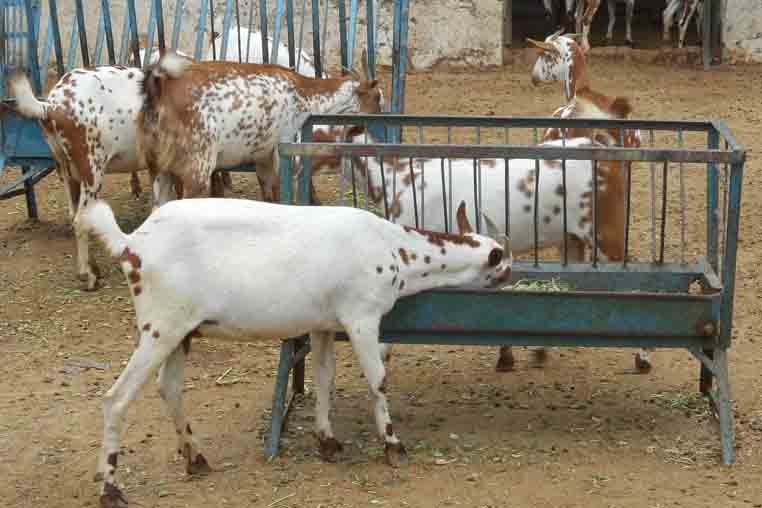Barbari goat farming 100+5 (100 does and 5 bucks)
Stall fed goat farm project report
Barbari goat farming business plan
Stall fed livestock farming is gaining popularity in India due to shrinkage and fragmentation of grazing land . change in eating habit of people is another cause for this increasing demand.. Due to increase in per capita income demand of meat and milk is increasing rapidly . Stall fed livestock farming is an intensive method of livestock farming in which animal remain confined in shed and are not permitted to go outside for grazing. In this system a paddock is generally provided in front of the animal shed where animals are let loose for exercise. Stall fed goat farming is a profitable business and it has several advantages.
Merits of Stall fed goat farming
1-Research proves that overall weight gain is significantly higher in stall fed group in compared to grazing group animals.
2-Occurrence of disease is less in stall fed goat as there is less chance of disease transmission from outside animals.
3-Disease detection is easy under stall fed goat farming as goats remain always under direct supervision of the farmer
4-Record keeping is easy in this system of farming
5-Breeding of does with preferred buck is easy and inbreeding can be easily prevented.
Breed- This project report is prepared on Barbari breed. This breed is a dual purpose breed used for both milk and meat production.
Assumptions
1-Quality disease free young Barbari goats between 12-18 months will be purchased
2- one hector of irrigated land will be utilized for intensive fodder cultivation.
3-Dry fodder will be purchased from local market
3-Manure will be utilized for fodder cultivation
4-In case of death of animals new animal will be inducted from insurance money
5- culled animal will be replaced with new young animals .New animals will be purchased from sell proceeds of culled animals.
6- It is assumed that litter size in first kidding is mostly single. From second year onwards average litter size 1.65
7- Kid born on 1st year will be sold in second year.
8-Entrepreneur /farmer will rear animals with proper care and attention and he/she will undergo training on goat farming before starting goat.
9- Before stating goat farm He /she will undertake market study to find out demand of goat meat and milk in local market
10- Veterinary facility must be available in nearby locality.
Avail Bank loan and subsidy– Subsidy limit under MKUY is 40% of the fixed capital (excluding the cost of the land) subject to a limit of 50.00 lakh for general male category. Subsidy is 50% of the fixed capital limited to 50.00 lakh for SC/ST/Women/Graduates of Agriculture and Allied Disciplines for this type project. Farmer/entrepreneur can apply through GO Sugam Portal. Net annual profit from the project should be more than 2 Lakh for individual & more than one lakh for SHG groups.
| Techno-economic parameters | |
| Breed of Goat | Barbari |
| System of rearing | Intensive |
| No. of breeding Bucks | 5 |
| No. of Does | 100 |
| Age of Does at the time of purchase | 12 months |
| Age of bucks at the time of purchase | 18months |
| Lactation length | 130 days |
| Milk yield per day/doe | 0.8 liter |
| Age at first kidding | 15 months |
| Kidding/ interval (Months) | 8 |
| No of kidding per year | 1.5 |
| Kidding percentage | 90 |
| Average litter size (average of single, twinning, Triplet, quadruplet) | 1.65 |
| Sex ratio | 1:1 |
| Mortality(%) Kids | 5% |
| Weaning period in months | 2 |
| No of kid born in first year | 150 |
| No of kids born from second year onwards | 222 |
| No of kid available for sale in first year | nil |
| No of kid for sale from second year onwards | 210 |
| Saleable age of kids (months) | 9 |
| Expenditure norms | |
| Covered Space requirement sqft .per for Buck | 20 |
| Covered Space requirement sqft. per for doe | 15 |
| Average Space requirement sq ft. per /kid | 5 |
| Cost of construction coved space (Rs. persft) Doe, Bucks ,Kids | 200 |
| Cost of equipment (Rs./adult animal) | 300 |
| Cost of green fodder cultivation (Rs./acre) | 12000 |
| Daily average requirement (KG) of green fodder/adult | 2 |
| Daily average requirement (KG) of green fodder/kid | 1 |
| Average dry fodder requirement /year for all in quintal | 130-170 |
| Cost of dry fodder/kg | 3 |
| Concentrate feed : Adult does/month | 6.75 kg per month |
| Concentrate feed for Bucks /month | 7.5 kg per month |
| Concentrate feed for Kids /month | 3.75 kg |
| Cost of conc. feed (Rs./kg) | 16 |
| Labour (No.) | 1 |
| Labour wages (Rs.per month) | 6000 |
| Insurance (as percentage of the cost of breeding stock) | 4 |
| Veterinary aid (Rs./adult/year) | 100 |
| Income norms : | |
| Sale price of Buckling | 5000 |
| Sale price of Doeling | 4600 |
| Sale price of goat milk/liter in Rs. | 36 |
| Income from manure is not assumed as it is used on the own farm for fodder cultivation. | |
| Sale of Gunny bags (Rs./bag) | 10 |
| Repayment norms: | |
| Repayment period (years) | 5 |
| Grace Period (years) | 1 |
| Interest rate(%) | 12 |

